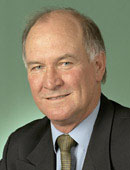The leaked report from the authoritative Intergovernmental Panel on Climate Change that appeared on 27th January, contains one chilling observation: “"Twenty-first century anthropogenic (human) carbon dioxide emissions will contribute to warming and sea level rise for more than a millennium, due to the timescales required for removal of this gas.”
In other words, even if we stopped emitting right now, it will take 1000 years for the CO2 levels to return to ‘normal’. The danger lies in the legacy load of CO2, the volumes we released over the past 200 years, that are likely to push the median world temperature past the critical 2°C mark and take us into climate chaos. And it is this CO2 that cannot be captured by “clean coal” technology and immobilized by geosequestration or buried in deep ocean trenches, the solutions favoured by President Bush and John Howard. Nor is it the CO2 that won’t be released when power is generated by solar or wind turbines. It is the CO2 that is out there and can’t be captured at source or substituted.
It has to be sequestered by the only means possible: by the natural processes that lock carbon up in trees and soils.
Many scientists have recognized the dilemma of the “legacy load”. “The carbon dioxide that’s in our atmosphere today – even if we were to stop emitting it tomorrow – would live for many decades, centuries and beyond,” said Dr Susan Solomon, senior scientist of the of the Global Monitoring Division of the U.S. National Oceanic and Atmospheric Administration. “A fraction of the carbon dioxide that we’ve put into the atmosphere today due to human activity would still be there in 1,000 years.”
Britain’s Chief Scientist Sir David King said that, “even if humanity were to stop emitting carbon dioxide today, temperatures will keep rising and the impacts keep changing for 25 years.”
Neither governments and scientists have plans to deal with the legacy load that will create the havoc. Instead, they focus entirely on future emissions. When they finally do focus on the problem, they will seek to back a winner. The obvious candidate is forest plantings. But these have inherent weaknesses.
"Most 'forests' sold as carbon sinks are plantations or tree farms which are less secure than natural forests. Tree farms start their life emitting tonnes of carbon because they tear up the vegetation that covers the soil, releasing CO2 into the atmosphere," says Carbon Coalition Against Global Warming convenor Michael Kiely. "Then herbicides are used to kill off other plant species that the birds and other wildlife rely on. The result is a biodiversity desert. Not an Australian forest."
Typically a tree farm will be a 'monoculture' - a one species environment - which lacks the 'resilience' to resist parasite and insect attack. This makes them susceptible to fire, which would release tonnes of CO2 into the atmosphere.
Tree farms are also a bad investment when it comes to storing carbon, when compared to the natural forest: A study reported in New Forests concluded that: "An area covered with a plantation managed for maximum volume yield will normally contain substantially less carbon than the same area of unmanaged forest". A similar study in Oregon found that a 450-year-old natural forest stored 2.2 to 2.3 times more carbon than a 60-year-old douglas fir plantation on a comparable site.
Tree farms are good for city-based investors and tree farming executives, but bad for rural communities. When a large industrial-sized operation buys up 10 neighbouring farms and puts them all under trees, the plantation pulls 10 families out of the local schools, 10 incomes out of the local economy. In most small districts this would mean the end of soclai infratructure like local medical and banking services as well as a deterioration of the community’s ability to support each other.
“A forest isn't the safest place to lock up your carbon if the climate scientists are right when they say Australia will have more bushfires of the type that have been ravaging forests all summer, " says Mr Kiely.
Trees cannot lock up CO2 for 100 years, as promised, because they start emitting CO2 as soon as they drop limbs and leaves which decay. Trees stop ‘sequestering’ carbon when they reach maturity.
Pro-forest green groups Greenpeace, WWF and Friends of the Earth have given tree farms the thumbs down.
Finally, trees aren’t going to save the world. We can’t plant enough of them in the time we have left, and not all soils are suitable. The UK Department of Energy estimates that to offset the UK’s total carbon dioxide emissions would require the planting of a new area of tropical forest about 1.5 times the size of the UK. "We don't have enough land to make up for all our emissions; you would need seven planets," say Tim Cadman, a PhD candidate at the University of Tasmania who has spent years researching the forestry industry and government forest policy.
The World Rainforest Movement claims that to compensate for the eight gigatonnes of carbon we currently release into the atmosphere every year would require planting four times the area of the United States with trees, never letting these trees die and decay thereafter. Millions of hectares of land would have to be taken over for carbon sequestration to have even a small impact on overall emissions.
But farmers can provide a solution. Given that 60% of the earth’s surface is grazing land, farmers have critical mass. They can sequester carbon at rates higher than tree farms using a combination of native perennial grasslands, foregone clearing of native forest, and regrowth of native vegetation as part of their farm plan. Australian farmers have done precisely this, enabling Prime Minister John Howard to boast that Australia has met its obligations under Kyoto 1, despite refusing to ratify the treaty. Not a cent was paid to the farmers who generated the ‘credits’.
So when you are buying carbon credits, insist on genuine, all-natural true forests and soil carbon credits – and vote 1 for ecology and the family farm.
……………………
STEM Jobs Help America Win the Future
12 years ago








